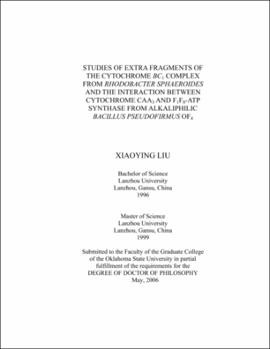| dc.contributor.advisor | Yu, Chang-An | |
| dc.contributor.author | Liu, Xiaoying | |
| dc.date.accessioned | 2013-11-26T08:22:54Z | |
| dc.date.available | 2013-11-26T08:22:54Z | |
| dc.date.issued | 2006-05 | |
| dc.identifier.uri | https://hdl.handle.net/11244/6654 | |
| dc.description.abstract | Scope and Method of Study: Although bacterial enzymes have simpler subunit composition than their mammalian counter parts, the sizes of core subunits (cytochrome b, ISP and cytochrome c1) are generally larger. Are these extra fragments required for bacterial bc1 complex? To answer this question, we studied two of these extra fragments through the molecular genetic manipulation of Rhodobacter sphaeroide (R.S.) bc1 complex at various positions of residues 421- 445 in cytochrome b and residues 96-107 in ISP. bc1 activity assay, SDS-PAGE, western-blotting, DSC, and EPR, were used to characterize the mutants. To elucidate the quinone binding site of the bc1 complex, we generated and characterized some mutants in R.S. bc1 complex based on the structural analysis of the low resolution of co-crystal of bovine bc1 complex with 5-Br-Q0C10. There is a hypothesis alkaliphile oxidative phosphorylation at very alkaline pH values involves the required respiratory chain proton pumping to the bulk phase to establish a membrane potential and also involves the use of one or more specific respiratory chain complexes to transfer protons to F0 sector of the F1F0 ATP-synthase during dynamic protein-protein interaction. To test this hypothesis, the interaction between cytochrome caa3 and F1F0-ATP synthase from alkaliphilic Bacillus pseudofirmus OF4 was studied by using DSC and saturation transfer EPR. | |
| dc.description.abstract | Findings and Conclusions: Our data demonstrated that both extra fragments are required for bacterial bc1 complex. The first 12 residues (residues 421- 432) of the C-terminal extra fragment of cytochrome b in the cytochrome bc1 complex from Rhodobacter sphaeroides are essential for maintaining structural integrity of the bc1 complex. The ISP extra fragment (residues 96-107) is found to be required for the structural stability of ISP in this bacterial bc1 complex. Both of these findings suggest that these two extra fragments possess the supernumerary subunit function in stabilizing the structure of the bacterial complex. Quinone binding site is an ongoing project, we haven't got very good results yet. From the results of DSC and ST-EPR experiments, we concluded cytochrome caa3 and F1F0-synthase from alkaliphilic Bacillus pseudofirmus OF4 exist as a supermacromolecular complex in the membrane. | |
| dc.format | application/pdf | |
| dc.language | en_US | |
| dc.rights | Copyright is held by the author who has granted the Oklahoma State University Library the non-exclusive right to share this material in its institutional repository. Contact Digital Library Services at lib-dls@okstate.edu or 405-744-9161 for the permission policy on the use, reproduction or distribution of this material. | |
| dc.title | Studies of extra fragments of the cytochrome bc1 complex from Rhodobacter sphaeroides and the interaction between cytochrome caa3 and F1F0-ATP synthase from alkaliphilic Bacillus pseudofirmus OF4 | |
| dc.contributor.committeeMember | Yu, Linda | |
| dc.contributor.committeeMember | Nelson, Eldon C. | |
| dc.contributor.committeeMember | Essenberg, Richard C. | |
| dc.contributor.committeeMember | Burnap, Robert L. | |
| osu.filename | Liu_okstate_0664D_1700.pdf | |
| osu.accesstype | Open Access | |
| dc.type.genre | Dissertation | |
| dc.type.material | Text | |
| thesis.degree.discipline | Biochemistry and Molecular Biology | |
| thesis.degree.grantor | Oklahoma State University | |
